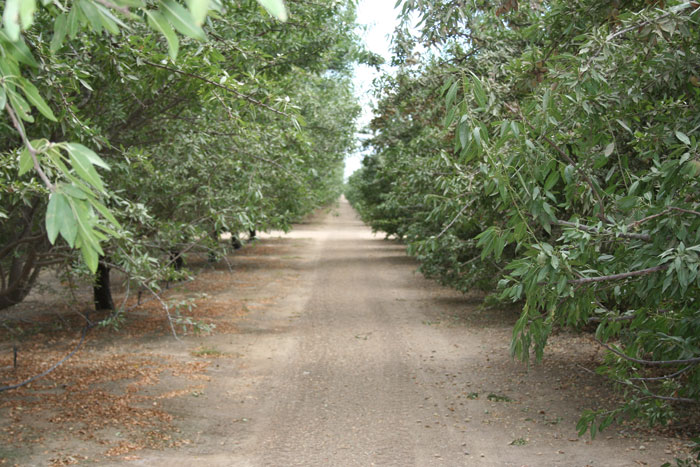April 6, 2016

It’s happened all too frequently to California pistachio grower Tom Coleman.
Walking in his Fresno County orchards on an early spring morning, he discovers dozens of three-five-year-old trees with two-foot-long sticks clipped off the ends of branches – the tell-tale sign of thieves who have made off with budwood to start their own orchards.
Based on reports from other growers, Coleman says his aren’t the only trees targeted this way. In fact, such incidences have been increasing over the last few years in response to the brisk demand for new trees to capitalize on the booming market for pistachio nuts, he adds.
The buds from the pilfered sticks are wrapped in damp towels and kept on ice to keep the wood fresh for no more than a day or two. The buds are carved out and slid into the bark of rootstock to form a new pistachio tree.
Done properly, removal of the budwood doesn’t damage the parent tree. In fact, this procedure is used commonly by commercial budders.
However, obtaining budwood without permission is not only wrong but it’s actually harming the pistachio industry. It reduces funding for public research and development of improved pistachio varieties, says Coleman, who also serves as chairman of the California Pistachio Research Board (CPRB).
Almost all new commercial pistachio acreage in the U.S. is grown from UCB#1 seed or rootstock. This hybrid of Pistacia atlantica (female) X Pistacia integerrima (male) was developed by UC researchers for resistance to Verticillium wilt and vigorous growth.
Licensing fees from the sale of the seed or rootstock of this hybrid, as well as the budwood of the UC-developed varieties - Golden Hills (female), Lost Hills (female) and Randy (male), help support the work of the university’s researchers and breeders in producing, testing, and distributing disease-tested plant propagation material, including pistachio cultivars.
Pistachio trees produced by commercial nurseries from tissues or clones are not subject to the University of California licensing fee.
The price of UCB#1 seed purchased under license from UC Foundation Plant Services is $1 per seed. The price for UCB#1, Golden Hills, Lost Hills, and Randy budwood is $50 for a budwood stick (about 6 inches long) with no less than four buds each.
Grafting budwood of Golden Hills, Lost Hills, and Randy is also subject to a licensing fee of $1 per bud.
Coleman, who farms several thousand acres of pistachio trees, prefers to start his orchards from seed.
“I think growing a tree from seed rather than planting a pre-budded tree produces the most vigorous tree,” says Coleman.
He buys the UCB#1 seed from the FPS, paying the $1 dollar per seed licensing fee.
After the seed is planted and grown to about 18-inches in height at several nurseries, Coleman plants the trees in his fields. Once five-feet tall, he hires a commercial budder to graft them with buds from wood removed from Coleman’s blocks of Golden Hills and Randy trees.
In addition to paying for these budding services, Coleman pays $1 per bud to the budder who then pays the licensing fee for the buds to the University of California.
Over the last few years, however, the demand for UCB#1 seed has far outpaced the supply, says Coleman. As a result, growers typically receive only a fraction of the amount of the seed they order from FPS. Coleman says this shortfall has contributed to the increased number of unlicensed growers.
Last year, Coleman paid $250,000 for the UCB#1 seed purchased from FPS.
“It’s not fair for growers like me who pay for this UCB#1 seed or budwood when others don’t. And, it’s not fair to the industry.”
Coleman can understand why some growers may be tempted to avoid paying the licensing fee. However with the industry’s rapid growth in recent years, some newer growers may not be aware of the licensing fee rules.
“One grower even asked me if the fee for budwood was a requirement or a donation,” says Coleman.
This is why Coleman and a small group of other pistachio industry leaders are proposing a California marketing agreement designed to encourage more growers to pay the licensing fees to help fund UC’s development of improved varieties.
Coleman says, “A marketing agreement is a way to provide legal standing for this proposed program.”
The CPRB, for example, is a California state marketing order, authorized in December 2007 through a grower referendum. The order operates under the oversight of the California Department of Food and Agriculture.
The CPRB uses mandatory assessments, paid by pistachio growers, to fund research on pistachio propagation, production, harvesting, handling, and preparation for market, and to provide educational opportunities and materials for pistachio growers.
The marketing agreement Coleman and his colleagues propose would be similar to current marketing orders for California’s citrus, grape, and strawberry industries. These orders help control quality and disease resistance of plant parent material except that the agreements are voluntary but binding on the signatories.
Pistachio nurseries and commercial budders participating in the proposed pistachio marketing order would agree to use only UC-licensed rootstock and budwood and budwood with the exception of their own proprietary varieties.
“I could see members of this agreement assessing themselves a relatively small fee to pay for reviewing the records of each other to check for compliance with the UC licensing program,” Coleman says.
A listing of these licensed growers and budders would be available to the public.
“This way any grower buying foundation material from an unlicensed producer would risk buying seed, rootstock, or budwood that might not meet the quality and disease resistance standards of those developed by the University of California,” Coleman explains.
His group plans to put the proposed marketing agreement to a vote of pistachio nurseries and budders this fall.
You May Also Like




